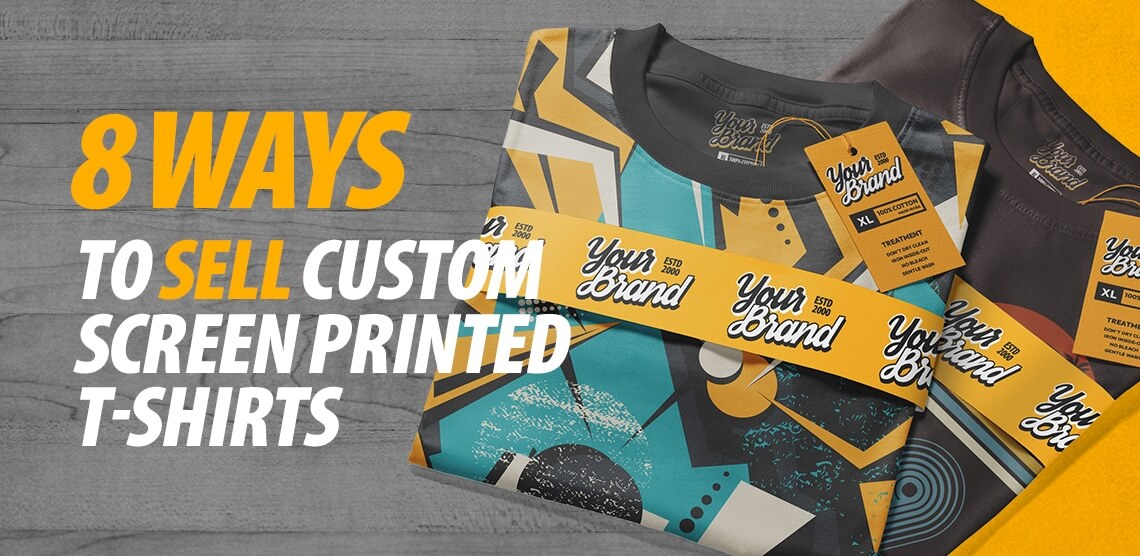Affordable Screen Printing Kit for Home Use
Affordable Screen Printing Kit for Home Use
Blog Article
Display Printing Uncovered: Whatever You Need to Understand About Tee and Garment Printing Methods
If you've ever wondered how those vibrant designs end up on your favorite t-shirts, you remain in the appropriate location. Screen printing is an interesting method that incorporates art with technique, offering unlimited possibilities for creative thinking. Recognizing the basics, from equipment to ink options, can considerably affect your results. Prepared to check out the crucial elements that make display printing an art kind? Let's reveal the information that can elevate your projects.
The Basics of Screen Printing: Just How It Functions
When you plunge right into display printing, you'll uncover it's both a scientific research and an art. At its core, screen printing involves producing a stencil, or display, that allows ink to pass with only in details areas (screen printing kit). You begin by selecting your design and preparing your display with a light-sensitive emulsion. When you expose this solution to light, it hardens, leaving your style as a negative room.
Next, you'll blend your inks and prepare your printing surface. Setting the display over the material, after that use a squeegee to press ink through the display onto the garment. This process calls for precision, as you desire clear, lively prints. After printing, you'll cure the ink with heat, guaranteeing it sticks to the fabric and lasts with washes. Each step is vital, and understanding them will raise your display printing skills, transforming straightforward garments into one-of-a-kind, expressive items.
Sorts Of Display Printing Strategies
As soon as you understand the fundamentals of screen printing, it's time to check out the numerous strategies that can elevate your designs. One popular technique is standard display printing, where ink is pressed via a stenciled screen. This strategy is fantastic for strong, lively shades. There's water-based ink printing, which offers a softer feeling and is eco-friendly, but it requires a different method to treating.
If you're intending for fine information, think about discharge printing. This method gets rid of dye from the textile, leaving a soft, classic look. An additional choice is plastisol printing, understood for its toughness and brilliant shades, making it a favorite for lots of brand names. Finally, try out halftone printing to produce gradient effects and detailed designs. Each method has its unique charm, so do not be reluctant to attempt them out to locate what matches your design best!
Essential Tools for Display Printing
To achieve sensational lead to display printing, having the best devices is basic. You'll need a tough display printing frame, which holds the mesh that transfers your style onto the garment. Next off, buy high-grade squeegees; these are important for using ink evenly across the screen. You'll likewise require a great exposure unit to develop your screens, as well as a washout booth for cleansing them after use. A trustworthy warmth source, like a conveyor clothes dryer or warmth press, is vital for treating your prints to ensure long life. Don't fail to remember a proper work space, furnished with tables and storage for your products. Safety equipment, such as handwear covers and masks, will certainly keep you secure from chemicals and inks. With the right tools, you'll be well on your method to generating professional-quality prints.
Picking the Right Inks and Materials
When choosing inks and materials for display printing, you need to take right into account the type of ink that functions best for your task. Think of textile compatibility to ensure your styles look last and fantastic long. Discover environment-friendly ink alternatives to make your printing procedure extra sustainable.
Kinds Of Screen Inks
Selecting the appropriate display ink is crucial for attaining vivid, long lasting prints that satisfy your project's requirements. There are a number of types of screen inks to examine. Specialty inks, such as glow-in-the-dark or metallic, can include unique impacts to your styles.

Fabric Compatibility Considerations
Recognizing textile compatibility is vital for achieving premium display prints, especially since different materials respond uniquely to various inks. Constantly evaluate your inks on example material to guarantee they stick appropriately and preserve color stability. In addition, maintain in mind that material weight and structure can impact the last outcome, so picking the best ink and product combo is essential for your job's success.
Eco-Friendly Ink Options
Environment-friendly inks are coming to be a preferred option for display printers who desire to lessen their environmental effect while maintaining quality. When selecting inks, consider water-based inks, which are less damaging and simpler to cleanse up contrasted to standard solvents.
Additionally, try to find inks made from eco-friendly sources, such as soy or vegetable-based options. By selecting the best inks and products, you'll not just produce magnificent styles however also contribute to an extra lasting printing procedure. Make the switch, and your prints will certainly show your dedication to the setting!
Preparing Your Style for Screen Printing

File Layout Requirements
To ensure your layout looks sharp and lively on material, you'll need to pay very close attention to submit format demands for display printing. Begin with vector documents like AI or EPS, as they can be scaled without losing top quality. If you utilize raster images, choose high-resolution documents, such as TIFF or PNG, ideally at 300 DPI. Stay clear of using JPEGs, as they can shed why not look here clarity when resized. Make sure your layout has a transparent history to protect against unwanted white sides on your prints. Keep color modes in mind; CMYK is common for display printing, so transform your RGB develops as necessary - screen printing kit. By adhering to these standards, you'll establish your art work up for an effective print.
Shade Separation Techniques
Shade separation is a crucial action in preparing your layout for display printing, and understanding it can considerably enhance your print top quality. You'll need to damage your style into individual shades, as each color calls for a separate display during printing. This accuracy not only ensures accurate color depiction however also simplifies the printing process.
Resolution and Dimension
Attaining the very best cause display printing starts with assuring your design has the appropriate resolution and dimension. Preferably, your art work should go to least 300 DPI (dots per inch) for sharp, clear prints. Your last item could look pixelated and less than professional. if you make use of reduced resolution.
When it pertains to size, consider the measurements of your print area. Layout your art work to match the final print size, ideally producing it in the actual dimensions you'll be publishing. In this manner, you'll avoid any type of unanticipated scaling issues.
Constantly check your layout in both vector and raster formats. Vector graphics can be scaled without shedding quality, making them perfect for display printing. Preparing appropriately will assure your design looks fantastic on every garment!
Step-by-Step Screen Printing Process
Screen printing is a vibrant process that permits you to produce dynamic designs on numerous surfaces. To get going, you'll need a screen, emulsion, and your chosen ink. First, prepare your screen by cleaning it completely. Next, apply the emulsion evenly and let it dry in a dark area. Once dry, expose your screen to light with your design put on it, which will certainly solidify the solution where the light hits, creating a stencil - screen printing kit.
Put ink onto the display and make use of a squeegee to push the ink with the stencil onto more helpful hints the fabric. Lift the screen very carefully and let the print dry. You've efficiently screen published your style.
Tips for Successful Display Printing Projects
While you're diving right into your display printing projects, bear in mind that prep work is key to success. Start by collecting all your products-- inks, garments, squeegees, and displays. A clean workspace helps stop undesirable mistakes, so clean prior to you begin.
Next, confirm your artwork is high-resolution and appropriately sized for your garment. Examine your screen for appropriate direct exposure and clean it extensively to prevent spots. When mixing your inks, follow the manufacturer's guidelines to achieve the best uniformity.
During printing, apply also pressure with your squeegee for constant results. Don't hurry; take your time to confirm each print meets your criteria. After printing, let your garments dry totally prior to taking care of or packaging them.
Finally, always keep an example of your benefit future recommendation. This means, you can examine your progress and improve your methods in time. Happy printing!

Regularly Asked Questions
How Lengthy Does It Take to Establish up a Screen Printing Job?
Establishing a screen printing job commonly takes about thirty minutes to an hour. You'll prepare the screens, mix inks, and adjust the press. The time varies based on intricacy and experience, so stay organized!
Can I Publish on Various Fabric Enters Using the Exact Same Method?
Yes, you can print on different textile types utilizing the exact same technique, however you'll require resource to change your inks and settings. Some textiles soak up ink in a different way, so trying out assurances the best results for every material.
What Prevail Blunders to Prevent in Display Printing?
When screen printing, avoid typical mistakes like making use of the incorrect ink, disregarding appropriate exposure times, or avoiding pre-press checks. Always check your setup and preserve clean displays to ensure quality outcomes each time.
How Can I Correctly Clean and Preserve My Display Printing Tools?
To correctly tidy and maintain your screen printing tools, you need to on a regular basis wash screens with ideal solvents, inspect mops for wear, and guarantee all tools are saved dust-free and completely dry. Uniformity boosts and protects against pricey repair work efficiency.
Is Screen Printing Environmentally Friendly Contrasted to Other Approaches?
Screen printing can be extra ecologically friendly than various other methods, particularly if you use eco-conscious materials and water-based inks. By choosing sustainable products and methods, you lower waste and decrease your effect on the planet.
Screen Printing Uncovered: Whatever You Required to Know Concerning T-Shirt and Garment Printing Techniques
At its core, screen printing involves producing a stencil, or screen, that permits ink to pass via just in certain areas. Placement the screen over the textile, after that utilize a squeegee to push ink through the screen onto the garment. One preferred approach is typical display printing, where ink is pressed with a stenciled screen.When choosing inks and materials for screen printing, you need to take right into account the type of ink that functions finest for your project.
Report this page